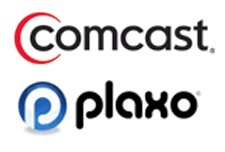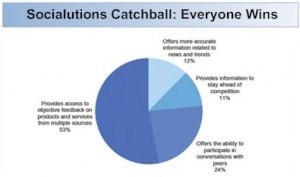part because of their customer
service problems and their image
of trying to control internet users.
Many mainstream bloggers feel the
same about Plaxo, calling it a “big spam machine” and calling its “Pulse” offering abysmal. When the announcement was made about Comcast acquiring Plaxo, the blog spin turned negative and the conversations took over. Comcast is already suffering relations in the “open social” world of the net. What appears as yet more fuel to Comcast current fires could actually be the calm before a bigger storm brewing on the fringes of convergence.
Putting the Pieces Together
Comcast has more than 25 million subscribers to either cable, internet or voice services. Plaxo claims to have 40 million individual profiles. The speculation, reinforced by Comcast press release, is that Comcast wants to provide video channels from the social web to the television and launch a new interactive cable box which will make “social networks” accessible via cable TV.
A Comcast Capital announcement says, “GridNetworks, a peer-to-peer television distribution company, has revealed that it has taken investment from Comcast Interactive Capital. The funding was part of a previously announced $9.5 million Series A round whose participants have trickled out over time and include Cisco Systems.”
Comcast is also investing heavily in WIMAX initiatives riding the wave of wireless access through multiple devices.

Comcast Capital’s recent investments and the acquisition of Plaxo suggest a peak into the big picture of intent. The playbook appears to be centric to convergence of media, access, content creation and user interaction across multiple channels of distribution. This is a bold move and one that would seem sound; however, the challenges of winning the people over are many.
The Socialutions Side of the Equation
According to a Forrester Research project, “Customers would rather deal with credit card companies and cell phone operators than their video providers, based on customer experience rankings compiled by Forrester Research Inc.”
“The best ranked video provider, DirecTV Inc., earned a mediocre “okay” in service from customers. On the Forrester-created scale, the direct-broadcast satellite leader scored an overall consumer experience index of 69 out of a possible 100. The ranking is based on consumer scores for categories including usefulness, ease of use and enjoyableness.”
”The highest ranked cable provider, Cox Communications Inc., also was rated just okay by consumers, with a score of 63%. Of the seven cable and satellite companies ranked by name, two earned scores that ranked them
“very poor” — Cablevision/Interactive Optimum and Charter Communications Inc. For their parts, Time Warner Cable and Comcast Corp. were ranked
“poor” in the analysis.”
The biggest challenge for Comcast lies in the relationship it has with the markets, the users and their related experiences. While their apparent strategy seems very sound, the ultimate judge is and will continue to be from the end users.
The current attitudes within the social sphere are suspicion, and concerns about privacy, security, intent and control are spreading faster than the positive possibilities of the apparent strategy. As with many other brands jumping into the emerging relationship economy, the trust factor between the people and the corporations appears to be critical cap.
The Socialution to bridging that gap will require new methods and new thinking centric to building community relations that instill trust.
Cabling Together: Is That Comcastic?
Whenever technology advances to
the point of usefulness, it is usually
because someone found a great fit
between two or more previously
independent offerings. In



techspeak, this has been referred to as a Mashup (adapted from the music industry).
Welcome the latest Mashup — between Internet delivery, Telecommunications, Television, Videos, and the social web at the minimum.
After the acquisition of Plaxo by Comcast, the next Mashup announcement will be that Open Social (Plaxo is in) will be incorporated into next-generation set-top boxes . . . and we will be
surfing the social web (again —
remember WebTV, it looks to be a
Microsoft product now) with a remote
(and that’s only the beginning).
Imagine yourself in the couch potato
position with your remote, and in the
corner of your wide screen you get a
transparent pop up message from
one of your Plaxo contacts wishing you happy birthday. You respond with a thank you, and he notes that you recently posted your status indicating you were en route to a celebration dinner.
He confirms the open invite, and
while you are on the way, you get a
text message on your mobile that
indicates the room you had reserved
has been upgraded due to an
additional twelve guests (pending
your approval). You confirm, and hit
the record video button on the dash
of your car (which could be a Ford,
using Microsoft Sync and a Live Mesh application) and record a video greeting that your guests see as they arrive.
Who would have expected that The Emergence of The Relationship Economy would be this imminent?
Should Companies Play Catchball?
As more and more brands
launch their own set of
“social initiatives,” a critical
failure is not involving
people in the verification of
whether their plans are really “social” or not.
Today people can see through the marketing spin and hype of messages quickly. The web is filled with opinions about everything, everybody, every brand and every move a company makes.
Case in point: Comcast announced the acquisition of Plaxo, and within hours there were hundreds of bloggers commenting on the move and their post went viral, one-to-one to millions. The initial blogger responses, in the aggregate, were negative about the Comcast move. Then more and more people expressed their opinions, and it appeared as though the negative spin caught on like wild fire. The bloggers with the most readers and the most respect seemed to “infect” the minds of many quickly and, rather than enabling objective dialog, entire communities, and the Comcast brand became subject to the negative infection.
When Will Companies Learn?
In modern management practices, there is a term and process called Catchball which originated from a planning process known as Hoshin Kanari.
Catchball is defined as:
“a communication process in which parties engage in a series of information exchanges about the means for achieving a particular objective. The purpose for the exchange is to build consensus around the best approach for achieving an objective. Catchball is based on the belief that the best approach will evolve from the back and forth exchange of information between the person who is responsible for achieving the objective and the persons who will be most influential in achieving it. The secondary benefit from using catchball is a higher degree of commitment to achieve the objective. ”
Now think of the social web as nothing more than a huge medium that enables the “catchball” process with entire markets, customers, suppliers and employees. If Comcast, or any other brand, were to take advantage of the medium they would learn more from the opinion leaders and their markets in a few hours and would avoid being caught in the negative spin. Additionally, people give their opinions freely, and those with loud voices of influences have gained their position because of their perspectives, understandings and thought leadership relative to the dynamics of the social web or what we have labeled as Socialutions.
The benefits to applying a “catchball mentality” is that by engaging community leaders and influencers in the process of strategizing “social initiatives,” you begin to develop a learning organization and your brand benefits from the ideas and opinions of the community of influencers.
Organizational learning allows a company to adapt to market changes and trends and grow in the process, and in some cases helps reduce the risk of

negative spin. Without the ability to learn and to be social as an organization, it lends itself to being criticized by the very communities of people it intends to serve.
How Could It Be Done and Protect Confidential Information?
We are not talking about telling the world you are about to acquire something and asking for their opinion. Rather, we are simply talking about the exchange of ideas on how a brand can improve its position by applying Socialutions.
However, let us just consider the recent Comcast announcement about acquiring Plaxo. Comcast could have invited and paid five of the top influencers and opinion leaders within the social web into a “Socialutions Advisory Council.” Without mentioning Plaxo Comcast could ask the proposed Advisory Council what their opinions were about Comcast buying or creating and using social applications. From this exchange, Comcast would have quickly learned of the pitfalls and opinions from the influencers before they made the acquisition. Additionally, the council could be under an NDA and shortly before acquiring Plaxo the council could be used as a “catchball” of feedback. This would have helped Comcast craft the appropriate messages that would help level set its vision with the active participants within the social web.
Much more could be accomplished using “catchball” strategies but this simply reinforces the scope of Socialutions possibilities.
Will Video Create the Next Shift?
Mediapost Research Brief
reports: According to data from
the comScore Video Metrix
service, U.S. Internet users
viewed 11.5 billion online
videos during March, 2008,
representing a 13-percent gain
versus February and a 64-
percent gain versus March
2007.
In March, Google Sites ranked
as the top U.S. video property
with more than 4.3 billion
videos viewed (38 percent share of all videos), gaining 2.6 share points versus the previous month. YouTube.com accounted for 98 percent of all videos viewed at Google Sites. Fox Interactive Media ranked second with 477
million videos, followed by Yahoo! Sites and Viacom Digital.
Other notable findings from the March survey include:
73.7 percent of the total U.S. Internet audience viewed online video.
84.8 million viewers watched 4.3 billion videos on YouTube.com (50.4
videos per viewer).
47.7 million viewers watched 400 million videos on MySpace.com (8.4
videos per viewer).
The average online video duration was 2.8 minutes.
The average online video viewer watched 235 minutes of video.
What Draws People to Video?
While online social computing has grown significantly, the initial means has been focused on textual communications, including blogs, chat, forums profiles, etc. Human interaction has multiple elements that enrich the communications process. Reading and writing is one composite aspect of social interaction while watching, listening and interacting takes the social dynamic to the next level. Virtual becomes reality when people can experience the emotions, attitudes and emphasis on words and view a person “in motion” so to speak.
Social broadcasting, whether it be branded programs or self produced programming, will likely continue to grow at accelerated rates with the advancement of user friendly video broadcast social applications. One such application we have examined, mentioned earlier, and are using is GoYoDeo http://www.goyodeo.com. The application currently enables users to produce video content and virtually distribute it through social networks or directly to their “friends list” without being tethered to any particular web site. The application also promises to integrate social contacts, blogs, micro-blogging, search, ratings and the host of all social applications into an all in one interface.
We have witnessed video blogging, the popularity of YouTube and other video aggregation sites; however, the next shift for virtual social broadcasting could likely produce yet another surge in user-generated broadcasts about anything, everything and everyone. The disruptive nature of such likely trends goes against the traditional broadcast medium of television already experiencing significant viewer migration to the net.

A Virtual Broadcast Network?
The Television has
been a widely used
telecommunication
medium for
broadcasting. The
word television is
derived from mixed
Latin and Greek roots,
meaning “far sight”:
Greek tele, far, and
Latin vision, sight
(from video, vis- to
see, or to view in the
first person).
Commercially available since the late 1930s, the television set has become a common household communications device in homes and institutions, particularly as a source of entertainment and news. From the 1930’s through the 1990’s Television was the primary source for people to receive broadcast. Then a shift began to take place.
Where have all the viewers gone?
Ellen Gray writes in the Philadelphia Daily News: “I wouldn’t want to be a TV executive this week, as broadcasters meet with advertisers in New York to talk about the fall season, make the case that network television’s still the place to put their ads and try to explain, yet again, where all those missing viewers have gone.”
Primetime TV viewing on the Web has gained considerably in the past year, according to a Solutions Research Group Survey. Based on the survey, 80
million Americans watched a TV show online last year. This number accounts for 43% of the online population, up from 25% who said they watched a TV
show on the Web last year. Additionally, 20% of respondents said they watch TV on the Web on a weekly basis.
Are We Witnessing an Era of The Virtual Broadcast Network?
Enabled by advancing social technologies, people of all ages are discovering
“broadcasting” as the new medium of self-expression in a virtual world of consumers following other consumers. YouTube was the beginning of user-generated broadcasting. Integrated into social networks, video is quickly becoming the new median of self-expression, and most analysts agreed that it is the next wave of social computing. Convergence of new technologies is making user-generated broadcast easy, viral, line and on demand and most of all “free.”

Enter the Virtual Broadcasting Network
Armed with advancing technologies, individuals and businesses alike can now produce their own broadcasting network with multiple channels that can be distributed virtually and not tethered to any particular web site or browser.
Marshall Kirkpatrick writes in ReadWriteWeb: Next Gen Apps Won’t Be Pushed Around By the Browser, From taking control of the browser to connecting to the web outside of it, there are a number of new strategies being implemented by startups these days.
We recently referenced the new application GoYoDeo (http://www.goyodeo.com) produced by The Floating Web Company.
GoYoDeo enables users to generate broadcast on the fly, organize them in channels and distribute them through any social network or embed them into blogs or web pages. GoYoDeo has plans to launch additional features including the integration of blogs, social connections, micro-blogging, RSS
feeds, search and a host of other features all into one application that floats throughout the web.
People are experimenting with the application and have found it user friendly and lots of fun. The market movements, user data and overall appetite for user-generated news and entertainment via broadcasting points clearly to the emergence of a Virtual Broadcast Network or VBN of which GoYoDeo may provide the entry points.
Is a Socialutions Battle Brewing?
A Mediapost article states: Microsoft
and Yahoo are back at the negotiating
table, according to a statement issued
by Microsoft on Sunday. Microsoft
began courting Yahoo Feb. 1 and
withdrew its $47.5 billion takeover bid
for Yahoo on May 3 after talks stalled
over price issues.”
“In light of developments since the
withdrawal of the Microsoft proposal to
acquire Yahoo Inc., Microsoft
announced that it is continuing to
explore and pursue its alternatives to
improve and expand its online services and advertising business,” the statement reads, most likely referring to Yahoo stockholder Carl Icahn’s bid to replace the Yahoo board. Icahn, a billionaire investor activist, recently started a bid to oust Yahoo’s 10-member board, which he accused of acting irrationally by opposing a merger. He proposed a slate of replacements to be voted on at Yahoo’s annual shareholder meeting on July 3.” A Battle for Control?
Robert Scoble writes: “ Let’s say Microsoft gets Yahoo’s search. That doesn’t look that brilliant. After all, we know Google is gaining share there and taking Yahoo’s best advertisers (and let’s just forget Microsoft’s efforts, which have been an utter failure so far).”
“But these two moves would change everything and totally explain why Facebook is working overtime to keep Google from importing anything. First, let’s look at what is at stake here:”
“Loic Le Meur did a little test with me a couple of weeks ago. He listed his Le Web conference on both Facebook and Upcoming.org. Here’s the Facebook listing. Here’s the Upcoming.org one.”
“The Facebook one can’t be seen if you don’t have a Facebook account. It’s NOT open to the public Web. Google’s spiders CAN NOT REACH IT.”
“He put both listings up at exactly the same time and did no invites, nothing.
Just let people find these listings on their own.”
“The Facebook one is NOT available to the Web. It has 467 people who’ve accepted it. The Upcoming.org one IS available to Google and the Web. It has 101 people on it.”
“This is a fight for the Web. We all just crawled inside a box that
locks Google out.”
“Now Microsoft/Yahoo search will have access to HUGE SWATHS of Internet info that Google will NOT have access to.” “It’s Facebook and Microsoft vs.
the open public Web.”
Big Moves Continue Elsewhere
Comcast Capital’s recent investments and the acquisition of Plaxo suggest a peak into the big picture of intent. The playbook appears to be centric to convergence of media, access, content creation and user interaction across multiple channels of distribution. A bold move and one that would seem sound, but the challenges of winning the people over are many.
How will Users Respond?
Scoble writes: “Can the open public Web fight back? Yes. It’s called FriendFeed. Notice that FriendFeed replaces almost all of Facebook’s killer features with open ones that are open to Google’s search.” These collective issues point to the clash of intents from both the media and technology side, which is a battle for control. Never before have the people had the power of communications and access, but the power is a threat to those who control it for economic gain.
We are witnessing an epic battle of historical proportion, and the momentum of the people and the unity of purpose will be the force to respond to the opposing attempts for control. Possibly, there is a Socialution that calms the battle and enables everyone to win.
References
Accessing Social Media. Retrieved May 14, 2008, from http://bp3.blogger.com/_gj0EOCObh34/SCtuXEESmpI/AAAAAAAAARM/T5Jx W-6covY/s1600-h/webtv.gif
Control of Internet Speech Image. Retrieved May 19, 2008, from http://balder.org/judea/Government-Money-For-Danish-Holocaust-Skeptic-Erik-Haaest.php
Gannes, Liz. (2008, May 18) Grid Networks: Comcast Invested in US Too.
Retrieved May 19, 2008, from
http://newteevee.com/2008/05/18/gridnetworks-comcast-invested-in-us-too/
Gray, Ellen. (2008, May 6). Ellen Gray: Networks dogged by drop in ratings.
Retrieved May 21, 2008, from
http://www.philly.com/dailynews/columnists/ellen_gray/20080506_Ellen_Gr ay__Networks_dogged_by_drop_in_ratings.html
Haugsted, Linda. (2007, December 11). Cable Providers Don’t Provide Much Service: Forrester Research. Retrieved May 19, 2008, from http://www.multichannel.com/article/CA6511485.html Internet Savvy Image. Retrieved May 24, 2008, from http://blogs.news.com.au/couriermail/education/index.php/couriermail/2007
/05
Live Mesh Image. Retrieved May 14, 2008, from https://www.mesh.com/Welcome/Welcome.aspx
Kirkpatrick, Marshall. (2008, May 20). Next Gen Apps Won’t Be Pushed Around By the Browser. Retrieved May 19, 2008, from http://www.readwriteweb.com/archives/post_browser_apps.php Mediapost. (2008, May 19). Microsoft, Yahoo Reboot Talks. Retrieved May 19, 2008, from
http://www.mediapost.com/publications/index.cfm?fuseaction=Articles.san&s
=82845&Nid=42861&p=459844
MediaPost Publications. (2008). Retrieved May 23, 2008, from http://www.mediapost.com/publications
Page, Bob. (2008). Hoshin Planning: Making the Strategic Plan Work.
Retrieved May 16, 2008, from
http://military.isixsigma.com/library/content/c071022a.asp Scarborough Research. (2008, May). Understanding the Digital Savvy Consumer. Retrieved May 24, 2008, from
http://www.scarborough.com/press_releases/Digital%20Savvy%20Free%20
Study%20FINAL%205.12.08.pdf
Scoble, Robert. (2008, May 19). Why Microsoft will buy Facebook and keep it closed. Retrieved May 19, 2008, from
http://scobleizer.com/2008/05/19/why-microsoft-will-buy-facebook-and-keep-it-closed/
Sync Image. Retrieved May 14, 2008, from
http://bp2.blogger.com/_gj0EOCObh34/SCtvM0ESmqI/AAAAAAAAARU/Y5dZ
pVDS5gU/s1600-h/sync.gif
Video Image. Retrieved May 23, 2008, from
http://www.adinfo-guardian.co.uk/online/news/video/images/video-welcome-image.jpg












